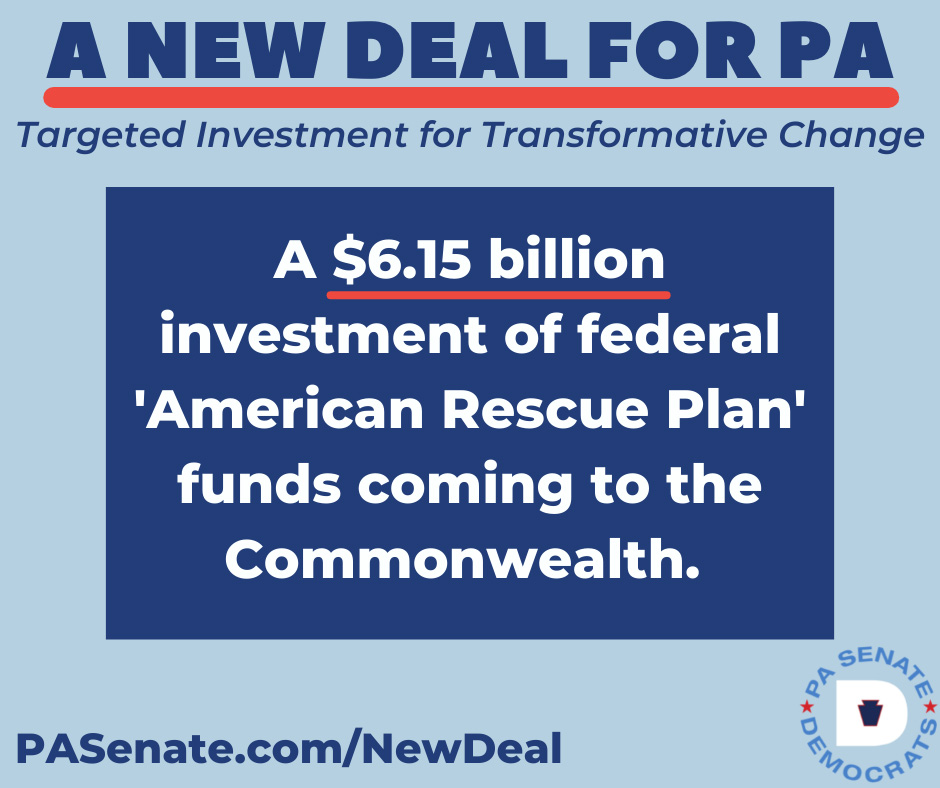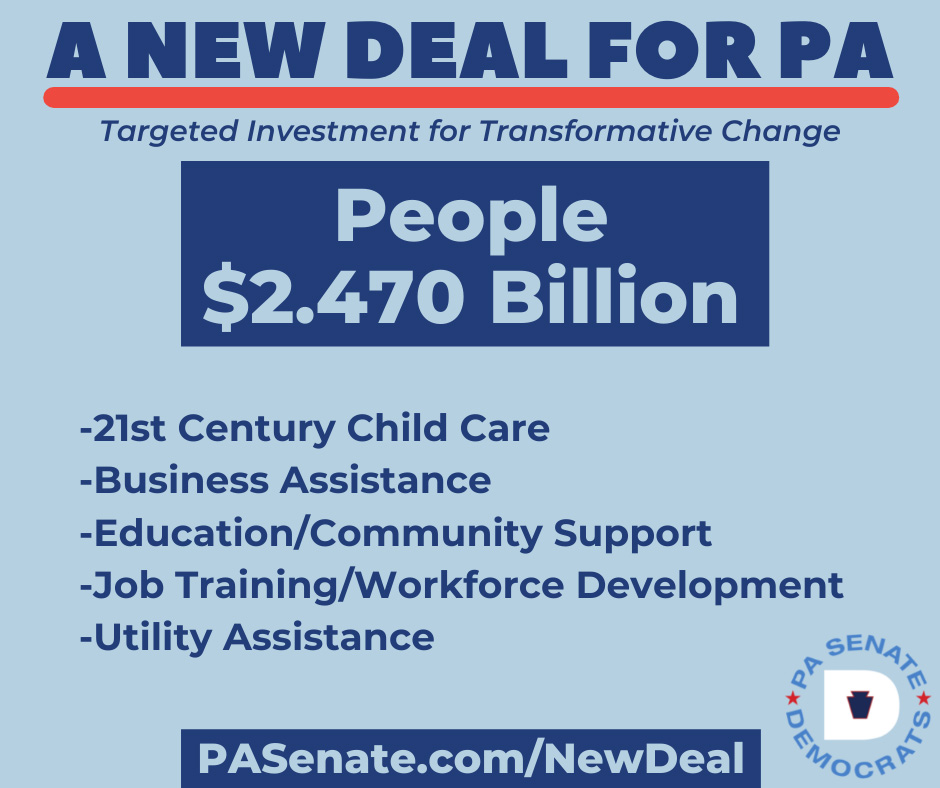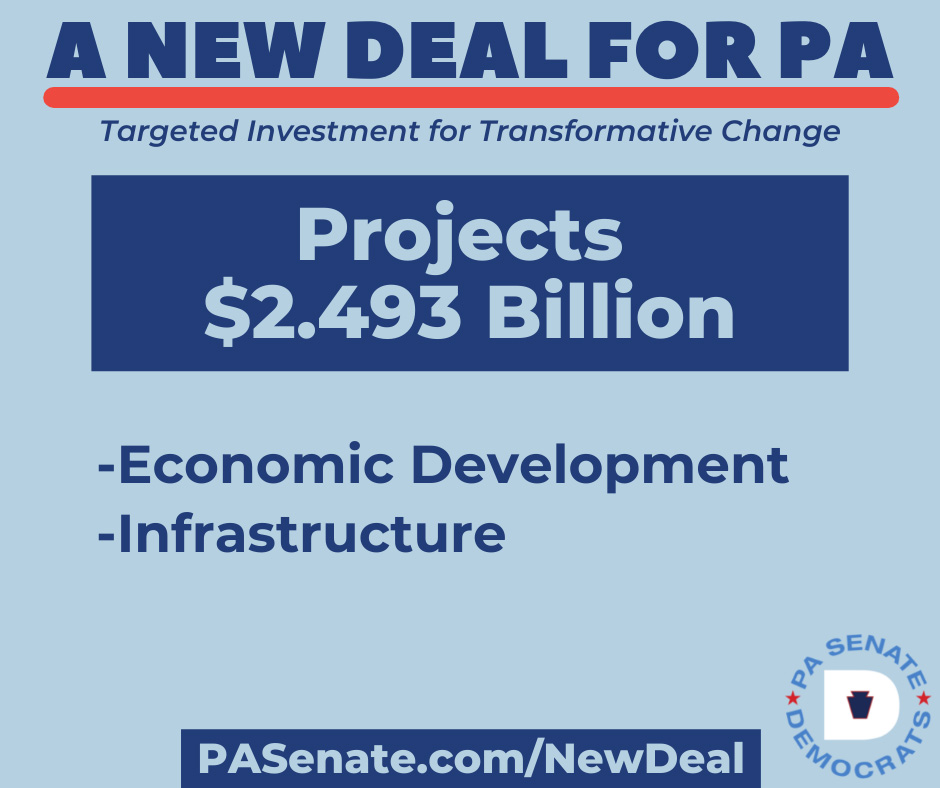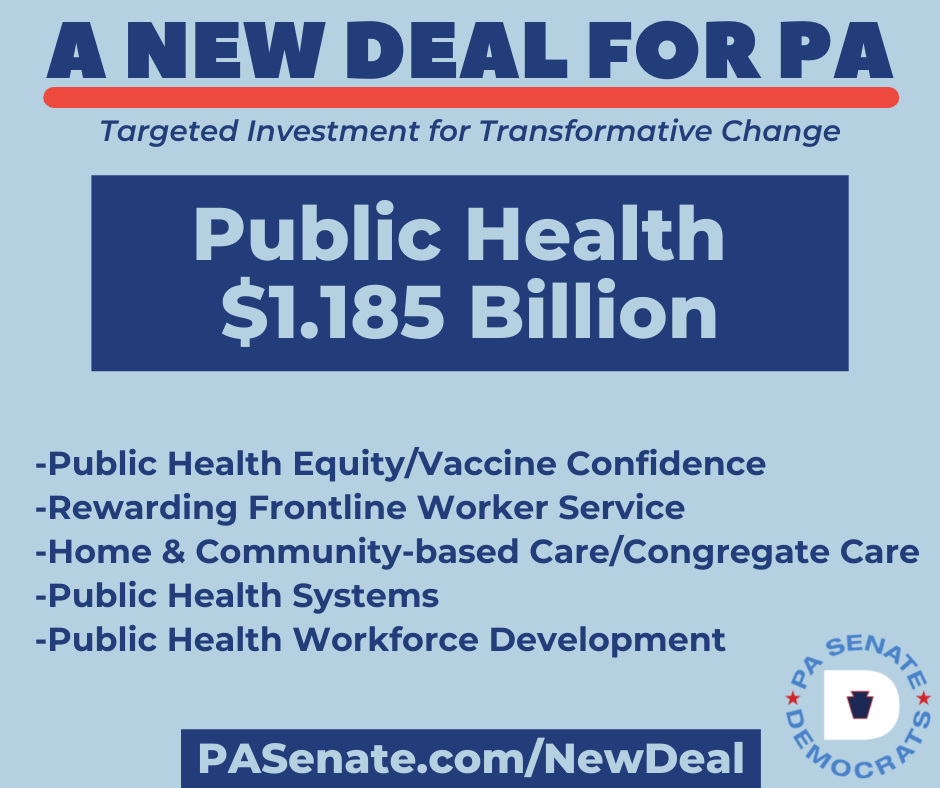A NEW DEAL FOR PA
Targeted Investment for Transformative Change
People
Projects
Public Health
PA Senate Democrats Introduce Spending Plan for $7 Billion in Federal American Rescue Plan Funds – The New Deal For PAs
May 12, 2021 – Today, Pennsylvania Senate Democrats unveiled the “New Deal for PA” – a $6.15 billion investment of federal funds coming to the Commonwealth pursuant to the American Rescue Plan.
El New Deal para AP se centra en el empleo, las oportunidades y la equidad, con el siguiente desglose:
People — $2.470 billion
21st Century Child Care
Business Assistance
Education/Community Supports
Job Training/Workforce Development
Utility Assistance
Projects — $2.493 billion
Economic Development
Infrastructure
Public Health — $1.185 billion
Public Health Equity/Vaccine Confidence
Rewarding Frontline Worker Service
"Estos fondos nos brindan una oportunidad única no sólo para tapar los agujeros creados por el año pasado, sino también para encaminarnos hacia una trayectoria que impida que se repita tal devastación, especialmente en lo que se refiere al impacto desproporcionado que sufrieron algunas comunidades", declaró el líder demócrata del Senado, Jay Costa. "Tenemos que ir más allá de los llamamientos a la simple 'reapertura' y centrarnos en la reconstrucción y la recuperación. Nuestras empresas, trabajadores y familias necesitan programas y sistemas de apoyo para llegar a una nueva normalidad."
Al realizar inversiones específicas en las personas, los proyectos y la salud pública, podemos utilizar esta infusión única de fondos federales en PA para realizar mejoras positivas y duraderas que sentarán las bases para crear un cambio transformador en toda la Commonwealth.
"Este plan, que crea empleo y oportunidades y da prioridad a la equidad, es el resultado de un largo y difícil año de escuchar y aprender", dijo Hughes, Presidente de Asignaciones Demócratas del Senado. "Miles de ciudadanos de Pensilvania han dedicado tiempo durante la pandemia a contarnos sus historias, sus retos y sus tragedias. Ahora tenemos una oportunidad histórica para aplicar las lecciones aprendidas no sólo del virus, sino también de las décadas de política pública regresiva que dejó a tantos tan vulnerables a ella. En resumen, este plan pone a la gente de AP en primer lugar".
El New Deal para AP utiliza un enfoque basado en datos para responder a lo aprendido durante la pandemia.
El caucus analizó la situación actual para determinar dónde sigue siendo necesaria la asistencia financiera para ayudar a las personas, las familias y las pequeñas empresas a recuperarse de los devastadores efectos de la pandemia. A continuación, el caucus miró hacia el futuro y evaluó la mejor manera de invertir los fondos del ARP para garantizar que salimos de la pandemia mejor de lo que entramos y crear resiliencia en toda la Commonwealth en preparación para la próxima crisis.
Por último, el grupo ha comparado su propuesta con las orientaciones del Tesoro de EE.UU. publicadas el 10 de mayo de 2021, para asegurarse de que tenemos una base sólida para utilizar los fondos como proponemos.
Orientación federal sobre los usos permitidos de los fondos que vienen a Pennsylvania de la American Rescue Plan ("ARP") Fondo de Alivio Fiscal del Estado se publicó el 10 de mayo de 2021. Pennsylvania recibirá aproximadamente $ 7.3 mil millones en fondos flexibles del Fondo de Alivio Fiscal del Estado. Demócratas del Senado creen que es hora de comenzar la conversación sobre la inversión de estos fondos para que podamos asignar el dinero con el presupuesto del año fiscal 2021-2022
La propuesta de los demócratas del Senado distribuye 6.050 millones de dólares procedentes de las siguientes fuentes:
State Fiscal Relief Fund — $4,797,500,000
Capital Projects Fund — $280,000,000
ESSER Fund — $505,000,000
Emergency Assistance for Nonpublic Schools — $150,000,000
Pandemic Response Fund — $25,000,000
Other Funds — $55,000,000
Local Matching Funds — $335,000,000
Los condados y municipios recibirán aproximadamente 6.100 millones de dólares del Fondo de Alivio Fiscal Local del Plan de Rescate Americano y los distritos escolares recibirán aproximadamente 4.500 millones de dólares del Fondo ESSER. Si estas unidades de gobierno local se acogen a estos programas, los fondos de contrapartida estatales ascenderán a una media aproximada de 4 $ por cada 1 $ de financiación local.
El plan del Caucus Demócrata del Senado se centra en las inversiones destinadas a lograr una recuperación justa para que Pensilvania pueda reconstruir mejor.




Frequently Asked Questions (FAQ)
Q: What are we announcing?
Senate Democrats are announcing the “New Deal for PA” – a $6.15 billion investment of federal funds coming to the Commonwealth pursuant to the American Rescue Plan.
Q: What are the principles and goals of the New Deal for PA?
The New Deal for PA focuses on Jobs, Opportunity, and Equity. By making targeted investments in people, projects, and public health, we can use this once-in-a-lifetime infusion of federal funds into PA to make positive, long-lasting improvements that will lay the foundation to create transformative change across the Commonwealth.
Q: Why are we announcing this proposal now?
Federal guidance on allowable uses of the funds coming to Pennsylvania from the American Rescue Plan’s (“ARP”) State Fiscal Relief Fund was released on May 10, 2021. Pennsylvania will receive approximately $7.3 billion in flexible funding from the State Fiscal Relief Fund. Senate Democrats believe it is time to begin the conversation on investing these funds so we can allocate the monies with the FY 2021-2022 budget. Time is of the essence.
Q: How much does your proposal spend? Where does it come from?
Our proposal distributes $6.05 billion from the following sources:
State Fiscal Relief Fund — $4,797,500,000
Capital Projects Fund — $280,000,000
ESSER Fund — $505,000,000
Emergency Assistance for Nonpublic Schools — $150,000,000
Pandemic Response Fund — $25,000,000
Other Funds — $55,000,000 Local Matching Funds — $335,000,000
To maximize economic impact, we propose partnering with our local governments by creating numerous programs that supplement local funds with state dollars. These programs, in areas such as repairing toxic schools, water/sewer/broadband infrastructure, and establishing county health departments will allow local governments to draw down significant state funding on top of voluntary local investments.
Counties and municipalities will receive approximately $6.1 billion from the American Rescue Plan’s Local Fiscal Relief Fund and school districts will receive approximately $4.5 billion from the ESSER Fund. If these local government units take advantage of these programs, state matching funds will average approximately $3 for every $1 of local funding.
Q: What areas do you focus on?
The New Deal for PA invests in 3 categories: People, Projects, and Public Health.
The Coronavirus pandemic exposed the fragility of our social safety net, the deficiencies in our government infrastructure, and the vulnerabilities in our education system, workforce, and economy. Fortunately, many of the issues the pandemic revealed are fixable.
Our plan targets investments to craft a just recovery so Pennsylvania can Build Back Better. (Download detailed breakdown and description)
People — $2.470 billion
21st Century Child Care
Business Assistance
Education/Community Supports
Job Training/Workforce Development
Utility Assistance
Projects — $2.493 billion
Economic Development
Infrastructure
Public Health — $1.185 billion
Public Health Equity/Vaccine Confidence
Rewarding Frontline Worker Service 3
Home & Community-based Care/Congregate Care
Public Health Systems
Public Health Workforce Development
Q: How did you determine priorities for funding?
El New Deal para AP utiliza un enfoque basado en datos para responder a lo aprendido durante la pandemia.
First, we looked at the current situation to determine where financial assistance is still necessary to help individuals, families, and small business recover from the devastating impacts of the pandemic.
Second, we look ahead and assess how we can best invest ARP funds to ensure that we come out of the pandemic better than we went in and build resiliency across the commonwealth in preparation for the next crisis.
Third, we compared our proposal with the U.S. Treasury guidance released on May 10, 2021, to ensure we are on solid footing in using the funds as we propose.
Q: What do you mean by a “data-driven approach”?
We looked at numerous data points that show the impact of the pandemic on certain individuals, communities, and economic sectors. For example, we know:
◼ Pennsylvania is still down over 400,000 jobs compared to pre-pandemic levels and we know the sectors that bore the brunt of the job loss.
◼ Thousands of women were forced to leave the workforce due to numerous factors, including lack of child care, schools closing, layoffs, etc., and that providing women, especially low-income women and women of color, with the tools needed to be successful is critical to their return to the workforce.
◼ Businesses in certain segments of the economy suffered great financial losses and may not have benefitted from the federal assistance programs like other businesses did.
◼ Black and brown-owned businesses and other historically disadvantaged businesses in communities of color were, and continue to be, disproportionately hurt by the pandemic and large numbers of these businesses were shut out of federal business assistance programs.
◼ Hundreds of child-care facilities closed their doors for good during the pandemic leaving working parents and guardians without access. Other providers were stretched to their financial limit with closures, lost revenues, lower enrollment, etc.
◼ Our home and community-based care providers and congregate care providers faced, and continues to face, significant challenges as they work their way through the pandemic.
◼ The inequity inherent in our K-12 education funding system was laid bare as children in low-income communities struggled with the challenges of remote and hybrid learning due to lack of equipment, internet access and other factors.
◼ The commonwealth’s IT systems were overwhelmed due to high demand in areas like unemployment compensation, professional licensure, and online liquor sales, resulting in unacceptable wait times to receive benefits or services.
◼ Substance use and mental health services are in high demand, especially in children and young adults, based on the physical and psychological effects the pandemic has taken on our citizens.
◼ Gun violence, domestic violence, hate crimes, etc. are increasing in whole or in part due to the stress caused by the pandemic.
◼ Our public health workforce and our essential/frontline workers have placed their lives on the line to help us weather the pandemic and deserve not only our recognition and respect but additional compensation.
◼ While resilient, our workforce, especially our public health workforce, must be strengthened through aggressive job training, recruitment and retention, and professional development initiatives that help create a world-class workforce.
◼ Equity in the delivery of COVID-19-related health services and vaccine hesitancy are major issues in communities across Pennsylvania, especially in rural communities and communities of color. Addressing these issues is key to ending the pandemic.
◼ Low-income communities and communities of color have been disproportionately impacted by the pandemic across the board. We cannot leave these communities behind as we recover. ARP investments must promote a “just” recovery for all, no matter an individual’s race, gender, ethnicity, sexual orientation, gender identity, disability, socio-economic status or zip code.
Q: Does the New Deal for PA solve all these issues?
No. But by using ARP funds to make these sound investments we can lay the strong foundation upon which future General Assemblies and future Governors can build to re-write the commonwealth’s future.
Q: How many jobs will the New Deal for PA generate?
We estimate the New Deal for PA will generate approximately 63,000 jobs (direct, indirect, and induced). The estimates are based on modeling done in September 2020 by researchers at the Political Economy Research Institute (PERI) at the University of Massachusetts – Amherst for job creation impacts of economic stimulus. The study focused on the care economy, public health, infrastructure, housing, and other areas.
Pollin–Sierra_Club_Job_Creation—-9-9-20–FINAL.pdf (umass.edu)
NOTE: To be clear, the PERI study was not a study of the New Deal for PA.
In addition, we believe thousands of additional jobs will be created and/or retained based on the direct assistance that we provide to small businesses
Q: Will you use existing programs or create new programs to drive out the funds?
Where appropriate, the New Deal for PA uses the programs created with CARES funds under Act 24 of 2020. We recommend some programs be revised to maximize effectiveness and comply with federal guidance. If proposed funding does not fit into an existing program (e.g., utility assistance), a new program will be created.
Q: What form will the financial assistance take?
The funds will be allocated as grants and will not need to be repaid.
Q: Are there restrictions on the use of these funds like the federal CARES Act.
Yes. The ARP lays out specific uses for the State Fiscal Recovery Funds. Federal guidance provides more information. We believe everything we’ve proposed complies with the federal guidance and is related to the Coronavirus Pandemic.
The American Rescue Plan specifically prohibits the commonwealth from using the monies to pay for tax cuts or for deposits into pension funds.
Q: The FY 2020-21 General Fund Budget was balanced in part by using $1.3B in federal CARES funds. That budget had the support of some Senate Democrats. Will these funds be used to balance the FY 2021-22 Budget?
Senate Democrats will strongly advocate for using American Rescue Plan funds as they were intended — to help Pennsylvanians. ARP funds are one-time revenues and won’t fix our structural deficit. This money needs to be put on the street so we can rebuild our commonwealth and our economy.
We believe current revenue and expenditure projections for FY 2020-2021 through FY 2022-2023 support investing the majority of the $7.3 billion we are receiving from the State Fiscal Relief Fund into our 3 main categories of assistance — people, projects, and public health. We reserve approximately $2.5 billion to address revenue changes we will face in the out years (e.g., expiration of savings we are seeing from enhanced FMAP). However, Senate Democrats believe these funds also should be spent if our revenue situation continues to improve.
Senate Democrats did not propose using CARES funds to balance the FY 2020-21 budget. It was not our preference, but the decision did not absolve our caucus of our responsibility to govern in a bi-partisan manner and ensure a budget crisis was not piled on top of the pandemic.
Q: Is this the ONLY money Pennsylvania or Pennsylvanians will receive from the American Rescue Plan?
No. The New Deal for PA distributes $6.15 billion from only the funds/sources mentioned above.
Commonwealth agencies, service providers, businesses, individuals, and others will receive funds either directly or indirectly from the federal government in the form of stimulus payments, unemployment compensation payments, loans, grants, subsidies, tax credits, etc. The total financial benefit Pennsylvania will receive from the $1.9 trillion American Rescue Plan is yet to be determined.
Q: What is the next step?
Federal guidance was released on May 10, 2021. We will continue to review it and seek clarification where needed. Under the statute, the Administration will have to submit a request to the U.S. Treasury for the funds. When we will receive the funds and whether we will get the funds at one time or in two tranches is to be determined.
In the meantime, we strongly urge the four legislative caucuses and Governor Wolf to begin conversations immediately on how to spend these funds.
